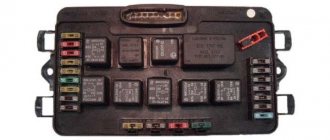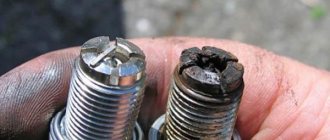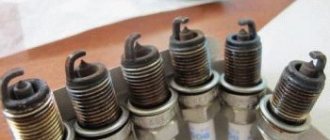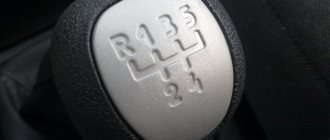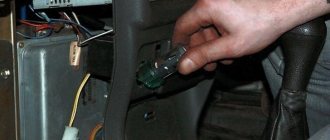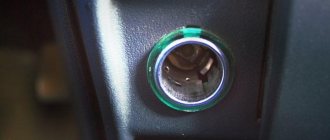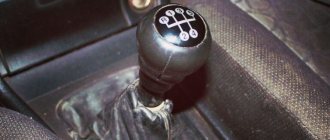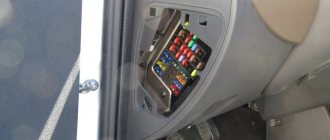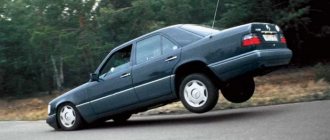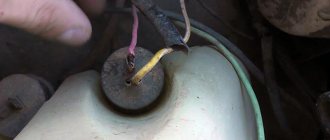Why are fuses needed?
Fuse links are required in the on-board network as a protective element. Each line provides a small safety margin, but in case of a short circuit this is not enough. In the event of a critical power surge, the wires or powered part may melt or ignite, which leads to serious consequences for the car.
Fuse links are calibrated by the factory to a certain threshold. When the mark is exceeded, the thin element is destroyed and the circuit opens, which “saves” the entire machine from fire.
Where is the main and interior fuse box of the VAZ 2114 located?
The car is equipped with two main mounting panels. The first part is installed inside the engine compartment. You can find the module on the left side in the direction of travel of the car. It is distinguished by a black or orange plastic cover. You can get to the fuse links and relays by opening the protective cover. This is done by pressing two latches.
The second part is mounted inside the cabin under the dashboard. To access the panel, you will need to open the service hatch in the front passenger's feet on the left side of the heater casing. Unscrewing 4 screws opens the panel itself. Here are relays and fusible links that control the operation of the main components of the machine.
Location of VAZ 2114 fuses in the main block
On the fourteenth Lada model, in 90% of cases two types of mounting blocks are used. The location of the internal parts and the pinout of the fuses of the VAZ 2114 are not significant, but they are different. Therefore, it is most convenient to consider both options separately.
Note!
Some modifications of the vehicle may be equipped with other module designs. You can find out the name of the variety on the inside of the lid.
Fuses for VAZ 2114 injector (block 3722010-60)
The module contains fuse links and automatic circuit breakers. All elements are marked in order.
Main unit relay
- 1 – Head optics wiper switch;
- 2 – Contact insert breaker of the turn signal and hazard warning signal mechanism;
- 3 – Responsible for the proper operation of the windshield wipers;
- 4 – Fuse for monitoring stop lines and vehicle lighting;
- 5 – Power supply to electrical accessories (window regulators);
- 6 – Horn control, main circuit;
- 7 – Power line for heating the aft glazing;
- 8-9 – respectively, control of high and low beam head optics.
Decoding the fuse diagram of the VAZ 2114 head unit
- F1 – fog lights at the rear of the car;
- F2 – control circuit for turn signals and hazard warning switch;
- F3 – power supply to the interior and luggage compartment lamps, also ignition indication, ECM;
- F4 – fuse for the aft wind window heating relay circuit; the portable lamp contact is also energized here;
- F5 – fuse for the signal of the VAZ 2114 and the head fan of the cooling system;
- F6 – is fully responsible for the electrical package circuit;
- F7 - standard fuse for the VAZ 2114 heater, also responsible for electric drives for the windshield washer, glove compartment lighting and headlight wipers;
- F8/9 – fusible links responsible for the front fog lights;
- F10/11 – backlight for the left and right sides, respectively, also responsible for illuminating license plates, cigarette lighter, and instrument panel;
- F12/13 – light fuse for VAZ 2114 for low-range mode on the right and left sides, respectively;
- F14/15 – similarly for the long-range lighting mode on both sides of the car separately;
- F16 - VAZ 2114 instrument panel fuses are responsible for indicating sensors and device status.
Main relays and fuses for VAZ 2114 in block type 3722010-18
A more modern modification, installed on cars since 2010. Here the arrangement of elements and fusible links is more thought out. Thanks to a more logical layout, individual elements are easier to access.
At the same time, not only the location of the fuses is different, their functionality and area of responsibility are also changed.
Head relays
- 1 – optical wipers;
- 2 – is responsible for the switch for turn signals and emergency lights;
- 3 – cleaners for the front part of the car glass;
- 4 – module for serviceability of lighting elements and backlight;
- 5 – control of the electrical package circuit;
- 6 – horn power supply;
- 7 – power conductors for heating the rear window;
- 8-9 – circuit breakers for high and low beam head optics, respectively.
Deciphering the VAZ 2114 fuse box diagram
- F1 – headlight cleaner contact connectors, also refers to the sprinkler tank motor activation valve;
- F2 – turns and opens the alarm when activated;
- F3 – illumination of the interior space of the cabin, power supply circuit for the side lights of the rear part of the vehicle;
- F4 – cigarette lighter fuse for VAZ 2114, overload protection for the heating element of the rear window, this also includes a portable lamp;
- F5 – VAZ 2114 fan fuse is responsible for cooling the antifreeze, also responsible for the horn;
- F6 – power supply for windows and electrical accessories;
- F7 – control lines for the front and rear sets of headlight and windshield washers – a complete circuit of equipment, this also includes the glove compartment lighting;
- F8/9 – front fog lights for the right and left sides, respectively;
- F10 – fuse for the lighting of the VAZ 2114, the cigarette lighter, the instrument panel indication, the engine compartment lighting, also the left side of the side light;
- F11 – separately for the right side of the side lights;
- F12-15 – power supply for head optics, complete lighting set;
- F16 – fuse for VAZ 2114 instruments, also coolant temperature indicators, voltmeter.
What is the MB for?
Repair manual for VAZ 2108, 2109, 2114, 2115 Wires and fuses
The electrical circuit of modern cars is quite complex even for experienced auto mechanics. Therefore, in order to ensure its maintenance and repair, a special approach was applied to the layout of each of the components of the overall system. To put it simply, almost all relays and fuses are placed in one compact housing of the mounting block - it is impossible to imagine a modern car without it.
This part is the central module of the car’s electrical equipment, which combines the control and protection of all electrical devices. The use of switching interconnected circuits of various electrical equipment systems makes it possible to avoid installing a large number of relays throughout the machine body and simplifies the process of repairing parts to replace them. There is no need to disassemble the entire car to find faulty elements. If the breakdown is serious, there is no need to arm yourself with a soldering iron. It is enough just to replace the device itself, which is connected to the circuit using standardized connectors.
Cabin fuses for VAZ 2114 - decoding of circuits and areas of responsibility
A separate fuse panel for the cabin unit is designed to control secondary circuits of electrical equipment. The main task of the module is to relieve the engine compartment and minimize the likelihood of breakdowns due to board overload.
In 90% of cases, the mounting block is equipped with a small set of inserts. This is due to the intended purpose of the device. In fact, such modules are installed here.
Relay
In the mounting panel, the control relays are arranged in sequence from left to right:
- Control of the fuel pump power cores. From here voltage is supplied to the main line.
- Main engine relay. Responsible for powering the ECU and parallel circuits of the primary control system of the vehicle.
- Breaker element for the power cores of the main fan of the engine cooling system.
There is also a similar number of fuse links. Each element works in tandem with a relay and is responsible for protecting the system from overload:
- F1 – VAZ 2114 fuel pump fuse, is responsible for monitoring the correct supply of voltage to the main line;
- F2 – fuse VAZ 2114 injector 8 valves, responsible for controlling the voltage of the car’s main circuit;
- F3 – fuse link going to the electronic control unit.
Functions of mounting block components
Mounting block 2114-3722010 contains up to 9 relays and 20 fuses. Experienced motorists who know the purpose and location of each element of the mounting block are able to independently diagnose and correct the malfunction. A hint in a difficult situation is the pinout - the correspondence of the functions of the contacts in the connectors according to the color of the wires to the numbers of the plugs of each electrical circuit.
VAZ 2114 was created on the basis of 2109, so the arrangement of the blocks is identical
The generally accepted designation of wires - two letter values - means: the first is the color of the wire (B - white, G - blue, F - yellow, etc.), the second is the color of the strip.
Removing the head unit
In some situations, it may be necessary to remove the mounting block. This is usually caused by voltage surges or part of the circuit burning out. Also, if fuses burn out on a VAZ 2114, the reason may be hidden in oxidized or melted tracks or connecting terminals.
When asked how to remove the fuse box on a VAZ 2114, you must follow the simple dismantling instructions:
- open the negative terminal on the battery;
- from the inside of the cabin, you will need to disconnect the five main connectors of the wiring harnesses;
- dismantle the cover of the mounting block by clamping two terminals;
- the sixth pin connector is disconnected on the top side of the module;
- using a key No. 10 with an adapter, you need to unscrew the fastening of the main module;
- lift the mounting diagram with a screwdriver;
- remove the last terminal blocks from the bottom side;
- remove the mounting device.
Reinstallation is performed in the opposite order. The simplicity of the procedure is due to the fact that all terminals are different from each other and it is impossible to confuse their location.
How to properly replace a burnt out element
You need to pull the fuses out of the corresponding sockets using special plastic tweezers, which can be found here, in the upper right corner of the VAZ 2114 mounting block. You cannot pry fuses on non-energized circuits with any metal objects due to the risk of a short circuit. It should be taken into account that the electrical circuits of the sound signal, alarm, etc. are always energized. To ensure safety when repairing the circuits, the circuit must be de-energized - you just need to disconnect the wire from the “negative” terminal.
It is not always possible to visually accurately determine the performance of fuses. It will be possible to make a clear decision only after the “ringing”. To do this, you will need a regular tester, which will need to be set in advance to the “dialing” mode. After this, it will be enough to simply attach two terminals of the tester to the terminals of the suspicious fuses. If a characteristic sound is heard, the fuse is good - the cause of the malfunction of the car’s equipment is not in it, but probably somewhere further in the wiring or in the device itself.
Lastly, never use copper “inserts” or fuses that are not rated for amperage. Using an inadequate replacement designed for a higher current, there is a risk of damage to the “track” of the unit’s printed circuit board and even failure of the electrical appliance. Insufficiently powerful fuses will not be able to ensure long-term and uninterrupted operation of the current consumer in the vehicle's electrical network.
Sometimes a car enthusiast has to deal with the fact that one or another electrical equipment of the car stops working. The cause can often be a normal fuse blown. To quickly replace a faulty fuse, you need to know where they are, what they look like, “figure out” the faulty ones and replace them correctly.
VAZ 2114 fuse blown, what to do
Periodically, voltage surges or other failures occur in the vehicle's electrical circuit. This leads to an overload in the circuits and the fuse link is destroyed.
If the breakdown is caused by a momentary failure, it is enough to replace the damaged element and everything will be fine. In the case of a larger defect, the new element will burn out as soon as the car starts. To fully diagnose the system and troubleshoot the problem, you will need to look at the entire line from the fuse to the consumer.
Important!
It is recommended to remove the fuses of the VAZ 2114 injector 8 valves only with special pliers or tweezers. From swinging to the sides, the thin legs of the part may break off.
Knowing the source of the problem will help make the search easier. Failure of the fuse element only occurs when there is a serious increase in voltage within the network, which is caused by a short circuit or system failure of the ECU.
The sequence of actions looks like this:
- remove the damaged element from the socket;
- find the corresponding wire on the back of the diagram;
- move along the highway to the consumer;
- detected damage must be eliminated; if the powered unit itself is damaged, replacement is carried out with a known good one.
Removal and replacement process
There is nothing complicated about this; even a novice car enthusiast can handle this process.
What will you need?
First of all, prepare everything you might need:
- new fuse to replace;
- sandpaper or stationery knife;
- screwdriver - if you don't have pliers.
The request returned an empty result.
Phased replacement
If you notice that the heater, backlight, cigarette lighter or fuel pump in your car has stopped working (the car will not start), then first you should check the functionality of the components themselves. Below we will consider the process of removing and replacing power supply parts.
- Open the hood of your car and find the location of the box. If you stand facing the hood, it is located on the right side. Disconnect the negative terminal of the battery, because all work on replacing electrical components must be done with the battery disconnected.
- Pry up the fastening clips of the power supply cover and remove it.
- Identify the failed element by visually inspecting it. On a blown fuse you will see a broken or melted fuse thread. However, not all contact performance can be determined immediately. It is quite possible that the socket itself where the element is installed is dirty or has formed corrosion, which prevents contact between the fuse and the circuit from being restored. Then take a knife with a thin blade (stationery) or sandpaper and clean the contacts with it.
- Take special pliers, which are also located in the power supply unit itself at the attachment point. Use them to dismantle the burnt fuse. If the relay fails, remove it by pulling it up and simultaneously swinging the relay left and right.
- Replace the burnt out component with a new one. Please note: the component must correspond to the rating, so if your 10 amp part fails, then you need to replace it with the same one.
- Close the decorative trim and check the functionality of the device that has failed. If its failure was due to the failure of the fuses, then after replacement everything will work.
The request returned an empty result.
Remember that you should never use a screwdriver to check the functionality of the contact.
In addition, you should absolutely not check the electrical circuit for a spark, as this can lead to a short circuit or burnout of the path along which the voltage flows. In this case, you will have to completely dismantle the power supply, turning off all devices, and also remove and replace burnt wires.
Follow all steps in the instructions and do not forget that the rating of the fuses being replaced must match. Otherwise, you will have electrical problems. Also, do not forget that if, when replacing an element, the problems in the operation of a particular device do not disappear, then you will need to check the electrical circuit and look for the reason in another.
VAZ 2114 fuses burn out - how to prevent
The easiest way to eliminate a breakdown is to take proactive action. High-quality and timely diagnostics help prevent breakdowns and sudden circuit failures.
The manufacturer recommends performing basic procedures in a timely manner.
- Treatment of contact groups with special oils. The products isolate metals from exposure to oxygen and water.
- Periodic control of the seating density of elements. Over time, mounting connections can become loose, leading to loss of contact and the potential for arcing, which can burn out metal parts.
- Strength of fastening of consumers in sockets. The size fuse of the VAZ 2114 may blow out if the light bulb dangles in the lampshade or water gets inside when it rains.
- Serviceability of blocks and main mechanisms. It is necessary to carry out diagnostics of vehicle devices in a timely manner. The VAZ 2114 starter fuse often fails when there is damage to the electric motor or the retractor element touching the body.
Memo
K1 – Relay that turns on the headlight cleaner
K2 – Relay for direction indicators and hazard warning lights
K3 – Wiper relay
K4 – Relay that determines the serviceability of brake light lamps, as well as side lights
K5 – Power window activation relay
K6 – Horn relay
K7 – Relay that closes the rear window heating circuit
K8 – Headlight high beam relay
K9 – Relay for activating low beam headlights
All devices marked with the letter F are fuses. Below is a breakdown of the symbols for each fuse.
F1 - rated insert current 10 A - fog lamps, as well as their indicator.
F2 - current 10 - everything related to the hazard warning lights, as well as direction indicators.
F3 - current 7.5 - lampshades in the cabin, trunk, on-board computer circuits, ignition and brake lights, "Check engine" warning light.
F4 - current 20 - socket for connecting a portable lamp, as well as heated rear window.
F5 - current 20 - sound signal and cooling fan.
F6 - current 30 - this is a circuit of electric windows and their switches with contacts.
F7 - current 30 - protective device for three electrical units - heater, windshield washer and headlight cleaner. In addition, there is also a cigarette lighter, glove compartment lighting and winding for the heating switch for the trunk door glass.
F8 - current 7.5 - this is protection for the right fog light bulb located in front.
F9 - current 7.5 - this is protection for the left fog light bulb located in front.
F10 - current 7.5 - protects the indicator lights on the left side, the license plate number, the engine compartment light, the dashboard lights and switches with heating levers, as well as the indicator lights for the size.
F11 - current 7.5 - protects the right-side headlight bulbs.
F12 - current 7.5 - protective device for the right low beam headlight bulb.
F13 - current 7.5 - protective device for the left low beam headlight bulb.
F14 - current 7.5 - protects the left high beam headlight and the blue high beam warning light.
F15 - current 7.5 - protects the right high beam headlight.
F16 - respectively, 15 - protects the light bulbs and switch-interrupter of turns and emergency lights, the white reverse light, the power supply of the instrument unit, the trip computer, the generator winding (at startup), the lights indicating low oil pressure, brake fluid and parking brake, discharge battery.
All other fuses perform a backup function and are used in the event of failure of one of the main ones . In addition, the mounting block contains a special tool that allows you to remove a relay or a faulty fuse, since doing this with your hands or fingers is very problematic. The code X11 indicates the connector for connecting the wiring harness.
It is worth noting that in some Samar models, the mounting block is installed directly in the cabin behind the car's dashboard. If you don't find it under the hood, it makes sense to find a special plug on the panel body.
As you can see, everything is quite simple. The most important thing is to keep these designations and in case of a malfunction, quickly find the fuse for this circuit. We wish you good luck on the roads!
